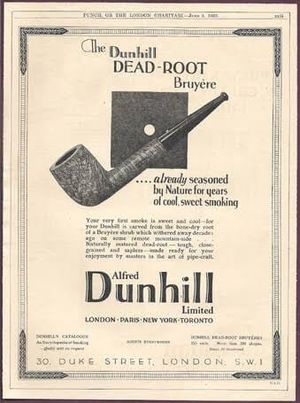Translations:About Dunhill Dead Root/1/en
Dunhill's most prestigious line, the "Dead-Root", is filled with many controversies, but certainly has its place in the sun. Among the connoisseurs of the brand, this is a very desired series. In addition to the pieces that were made under the management of Alfred Dunhill (until mid-1928) and limited in number, the D.R. has a special place in the heart and collections of nearly all Dunhill collectors.
Beginning by at least 1915 if not earlier (perhaps as early as 1910) Dunhill stamped straight-grained Bruyeres, and later straight-grained Roots, "DR" on brand side of the bowl at the place where one would normally find an "A" or "R". "DR" stood for dead root a term used to refer both to that part of the briar from which most quality pipes, including Dunhills, are made and to a briar burl that was dead before it was harvested. Initially, however, there was an additional distinction conveyed in the "DR" stamping beyond graining since prior to 1920 DR's were hand-cut in London from burls while most Bruyere's were only finished in London from French turned bowls.Loring, J. C., The Dunhill Briar Pipe, The Patent Years and After (self-published, Chicago, 1998).
While to some extent the straight-grained DRs may be the result of spotting the grain in the course of the early production process, the common statement that 'DR's are rare because they supposedly occur by accident in the course of standard shape production is incorrect. In fact, most "DR"s are derived from inspecting raw briar for straight grain prior to production or specifically purchasing the same and when so found or purchased selecting or specially designing a pipe shape to best fit the grain.
As the Bruyere was Dunhill's only smooth finish prior to 1931 all early DR's are necessarily Bruyeres," The Root finish was put in production in 1931 specifically because the company desired to have a better grained naturally finished pipe in the line and in 1932 DRs became associated with that finish. Prior to 1932 DRs were stamped simply "DR" but with their introduction, Root DRs were stamped "DRR". Presumably, the second "R" signifies the Root finish. Since I have seen no examples I do not know if Bruyere DRs after 1931, if any, were stamped "DRA" but I suspect that at least for a brief time there may have been such and if so, were so stamped since otherwise the second "R" in the Root DR stamping would have been unnecessary.
As discussed in connection with the "A" stamping, prior to the war, if not after, up ticking in DR pricing was apparently signified by square subscript stops. In addition it appears that early DRs dating from the 1910s to the early 1920s were stamped with a one or low two-digit number on the shank next to the bowl (where the shape number normally appears) which appears to be some sort of category (as opposed to shape) number, either price or shape related. (I suspect it was the latter, perhaps the forerunner of the initial Shell stampings in that regard.) The Dunhill catalogs of the 1920s through 1931 consistently show four DR price categories but the precise stamping code to indicate the different price levels is presently unknown. Presumably, there were differing price groupings of the Root DRs in the 1930s but number of such and stampings indicative of the same is presently unknown. In the 1950s Dunhill began grading DR's "A" through "J", "J" being the finest. I have seen a 1957 DR stamped "DRR" followed by a horizontal "H" presumably signifying the "H" grade but I do not know the significance, if any, of the horizontal manner of the stamping. In 1979 Dunhill changed it's DR letter grading system to stars running from one to seven stars underneath the "DRR" stamping with seven being the highest grade and also introduced a DR over XL stamp, presumably to denote larger pipes.
